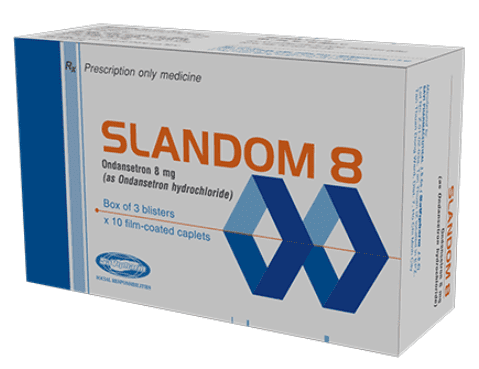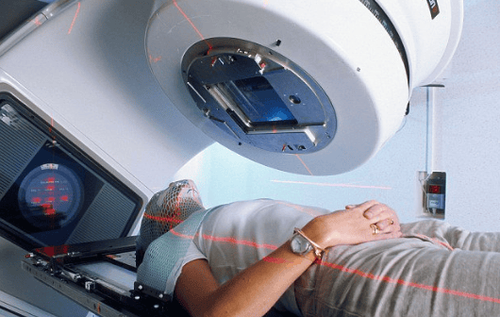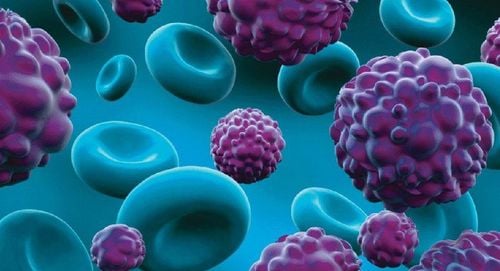This is an automatically translated article.
Brachytherapy is one of the cancer treatment methods that use a high dose of radiation energy delivered directly to the tumor. This helps to restrain and destroy the malignant cells, limiting the risk of spreading around.
1. What is brachytherapy?
Brachytherapy also has the same basic principle of radiation therapy that uses energy from X-rays, an invisible form of high-energy radiation, to kill cancer cells and shrink tumors. The radiation source kills cells by breaking down molecules and causing reactions that damage living cells. Sometimes cells are destroyed immediately; sometimes certain components of cells, such as their deoxyribonucleic acid, are damaged, thus affecting the cell's ability to divide later, and they self-destruct.
The use of radiation is often given by sophisticated devices that produce high-energy X-ray beams. The patient lies on the bed under the machine and the beam is directed at the cancer site. If external beam radiation is from a remote source aimed at the body, with brachytherapy, a radiation source is placed inside the body close to the cancer or tumor cells, for greater specificity.
Today, thanks to the development of technology, the detection of cancer has been made earlier and the means of treatment have also improved a lot. With brachytherapy, the radiation sources were placed as close as possible to the tumor site. Sometimes, they can be inserted directly into the tumor. Since then, brachytherapy has achieved certain achievements, especially effective in the treatment of cervical, uterine, vaginal, rectal, eye and some head and neck cancers. The technique is also sometimes used to treat cancers of the breast, brain, skin, anus, esophagus, lung, bladder, and prostate, improving survival rates.
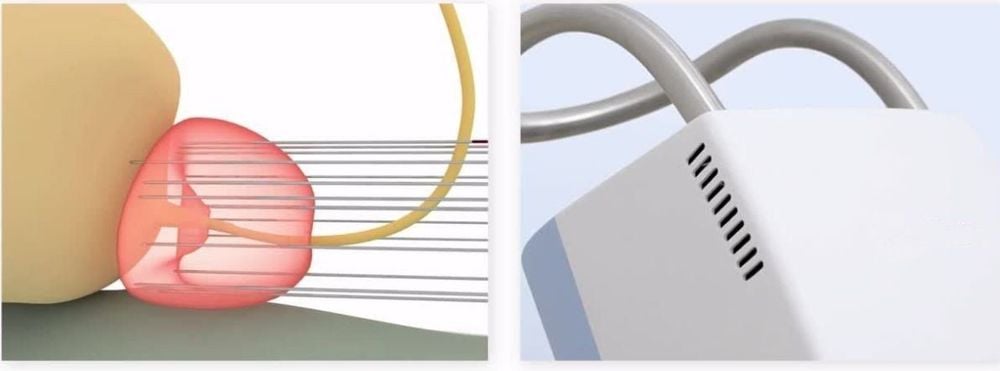
Xạ trị áp sát sử dụng chùm tia X năng lượng cao điều trị tiêu diệt khối u
2. Types of brachytherapy
Depending on tumor type, stage and accessibility, radiation dose parameters and treatment method will be the basis for classification in brachytherapy as follows:
2.1 Radiation dose rate High-dose brachytherapy: Use sources that release high doses of radiation in short sessions, each lasting a few minutes. The sources will be deleted at the end of each irradiation session. Low-dose brachytherapy: Use sources of low radiation release but for days, weeks, or months. The sources can be temporary or permanent. 2.2 How to treat Depending on the type of cancer and the doctor's orders, radioactive sources can be placed in the patient's body for a limited time or permanently.
Interim treatments: In palliative treatments, the radioactive sources are removed at the end of each course of treatment. The sources are usually inserted into the body, reaching the tumor using injectors such as catheters or cylinders. Temporal treatments are mainly used for prostate cancer and gynecological cancers (such as cervical and vaginal cancers).
Permanent treatment: In permanent therapy, radioactive seeds, about the size of an uncooked rice grain, are placed inside a special needle and implanted in the body. The needle is then withdrawn and the radioactive particle is left to decay gradually. As the particle decays, small amounts of radiation are released over weeks or months. Finally, when the energy is exhausted, the particle will stop releasing radiation, but the particle will not be eliminated, but will become an inert material that resides in the body, causing no harm. This is a low-dose radiation technique and is commonly used to treat small prostate cancers.
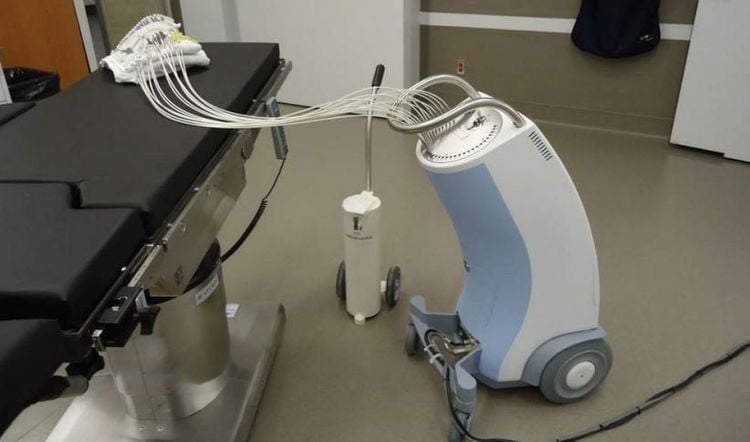
Hình ảnh hệ thống máy xạ trị áp sát liều cao
3. Indications for brachytherapy in which types of cancer?
Brachytherapy is indicated in cancers detected at an early stage, small in size and have not invaded nearby organs as well as distant metastases as follows: Bile duct cancer Brain cancer Breast cancer Cervical cancer Endometrial cancer Esophageal cancer Eye cancer Head and neck cancer Lung cancer Pancreatic cancer Prostate cancer Rectal cancer Skin cancer Soft tissue cancer Vaginal cancer Furthermore, brachytherapy can be used alone or in combination with other cancer treatments. For example, your doctor may prescribe brachytherapy after surgery to kill any remaining cancer cells. In addition, brachytherapy can also be used together with external beam radiation to increase the effectiveness of radiation therapy.
4. Advantages of brachytherapy and possible limitations
Radiation therapy to the tumor, which works from within the body, has been developed and applied to reduce the risk of recurrence while shortening the time needed for radiation treatment. Internally released radiation sources also help limit the radiation dose required (with associated side effects) to surrounding normal tissues. Thus, compared with external radiation, the technique of brachytherapy to the tumor from the inside has a number of benefits as follows:
Shorter treatment time: Brachytherapy can be started at the time of surgery. will have a shorter treatment time. Localized irradiation area: Because the radiation source is only released to the area around the tumor, it improves the efficiency of killing malignant cells with low radiation doses. Furthermore, because the body receives less radiation, there may be fewer side effects from radiation therapy. Reduced risk of recurrence: Preliminary results from several studies on the application of brachytherapy to the tumor to date suggest a very low risk of recurrence after internal radiotherapy.
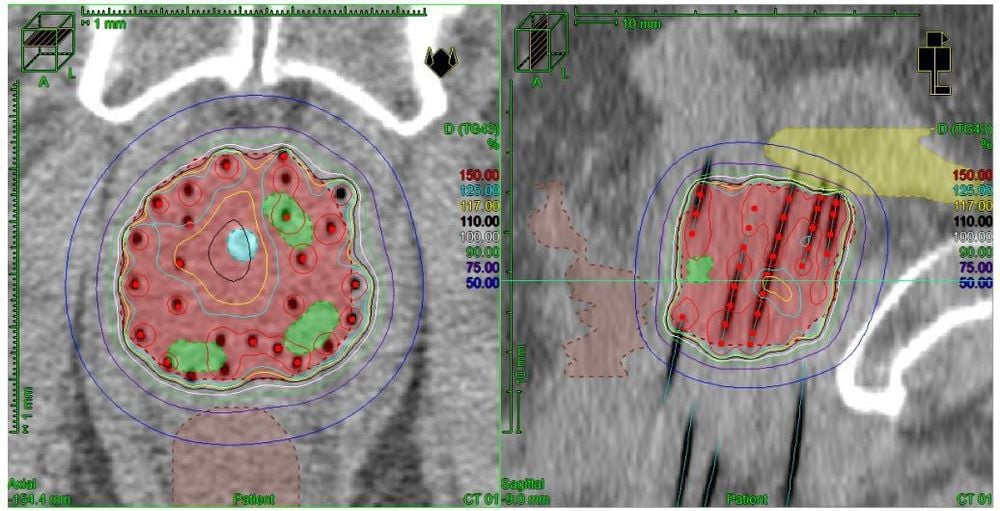
Xạ trị áp sát tuyến tiền liệt, cho thấy sự linh hoạt của Kích thước bước Flexitron: màu xanh lá cây DIL; PTV màu đỏ; bàng quang màu vàng; trực tràng nâu)
However, radiation therapy close to the tumor may still have some unknowns involved, becoming limitations that need to be carefully considered by the oncologist, giving clear advice to the patient and family before proceeding. onion.
Difficult to monitor long-term: When a source of radiation is introduced into the body, it is difficult to monitor these sources. This means that the benefits or even the side effects of internal radiation are not fully understood. Limitations of indications: Indications for brachytherapy are only applicable to cancers with easy access. Moreover, this technique will be highly effective in patients with small and localized tumors. Technical limitations: Most of the techniques for performing brachytherapy have been developed in recent years. Therefore, the team of technicians also requires additional training and experience and skills.
In summary, brachytherapy is a cancer treatment method based on the principle of using radiation and directly approaching the tumor. The advantages of brachytherapy have been gradually demonstrated, improving the patient's prognosis in certain types of cancer. However, this technique still requires carefully considered indications as well as technical skills to achieve optimal results for the patient.
Early cancer screening is considered a perfect measure in the timely detection and treatment of all types of cancer. Reduce the cost of treatment and especially reduce the mortality rate in patients. Vinmec International General Hospital always deploys and introduces to customers a HIGH-TECH CANCER CHECKLIST PACKAGE to help with gene testing, imaging, and biomarkers for early tumor detection. Vinmec International General Hospital has many packages of early cancer screening.
Only one gene test can assess the risk of 16 common cancers in both men and women (lung cancer, colorectal cancer, breast cancer, pancreatic cancer, neck cancer) uterus, stomach cancer, prostate cancer,....) Early detection of early signs of cancer through imaging, endoscopy and ultrasound. The operation is simple, careful and accurate. A team of well-trained specialists, especially in oncology, are capable of handling cancer cases. With facilities, advanced and modern medical equipment and a team of doctors with deep expertise and experience. At Vinmec, the examination process becomes fast with accurate results, saving costs and time for patients.
Please dial HOTLINE for more information or register for an appointment HERE. Download MyVinmec app to make appointments faster and to manage your bookings easily.
SEE MORE
Notes when taking care of radiation cancer patients Things to know about breast cancer radiation therapy Vinmec is equipped with the most modern cancer radiotherapy machine in Vietnam




